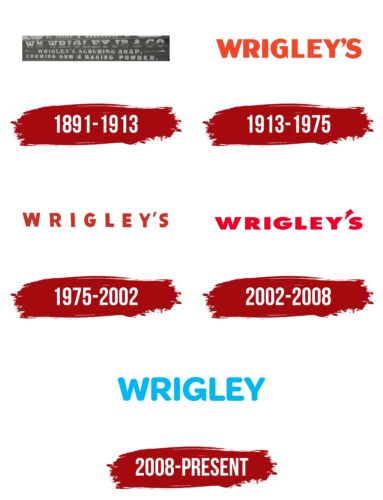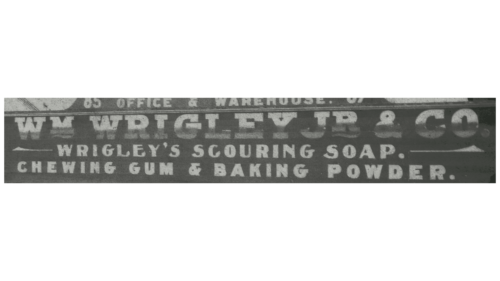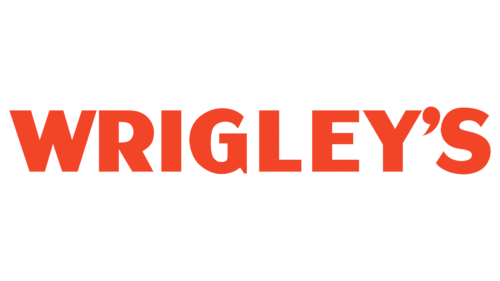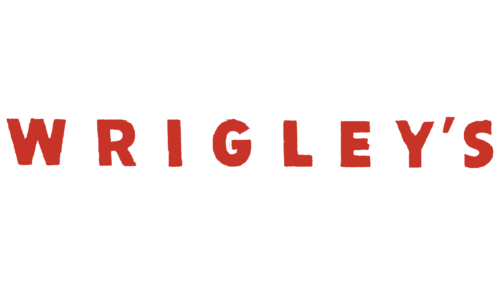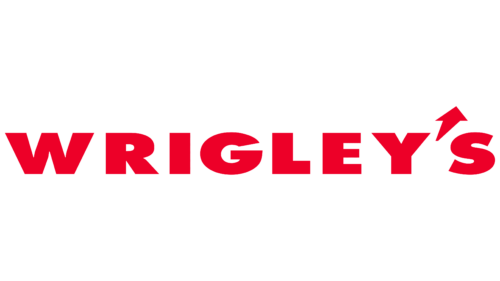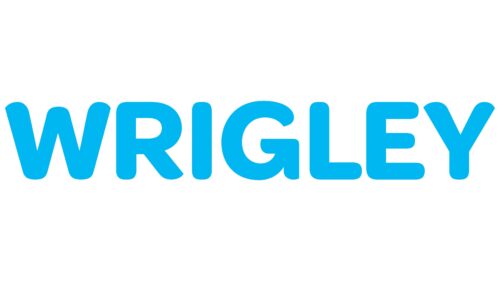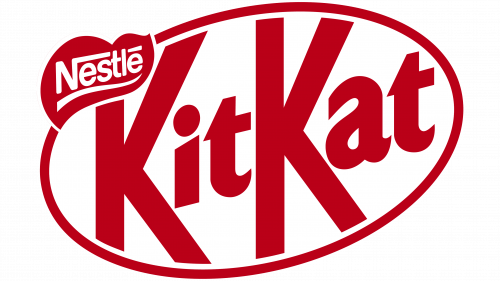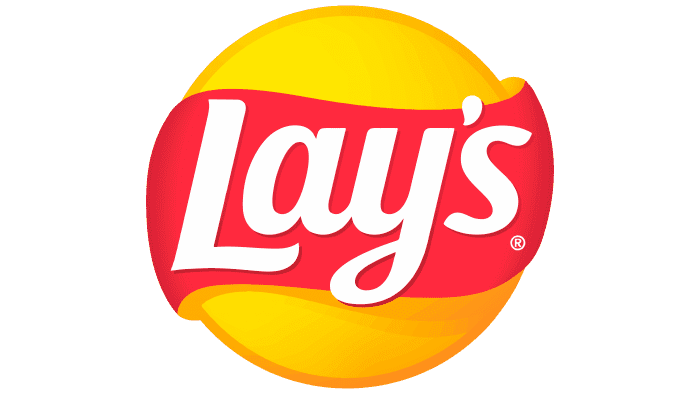The Wrigley logo represents a long history of innovation and tradition in chewing gum production. This emblem has become synonymous with the freshness and enjoyment the brand offers its consumers. The logo highlights the company’s commitment to creating products that provide instant refreshment and lift spirits. Wrigley aims to create delightful taste experiences, making moments of pleasure accessible to everyone seeking a bit of freshness in their day.
Wrigley: Brand overview
In 1891, William Wrigley Jr., at 29, moved to Chicago from Philadelphia. He initially sold soap but soon found that baking powder, which he offered as a bonus with the soap, was more popular. Quickly adapting, he shifted his business focus to baking powder. By 1892, Wrigley discovered that chewing gum, given as a bonus with baking powder, had an even greater appeal. This led him to focus entirely on chewing gum, launching Wrigley’s Spearmint and Juicy Fruit in 1893. These products stood out for their quality and unique flavors, setting the stage for Wrigley’s success in the chewing gum market.
During the early 20th century, Wrigley’s growth accelerated through innovative advertising strategies, such as giving away free samples and investing in widespread advertising. This approach helped Wrigley become the leading chewing gum manufacturer in the U.S. By donating millions of gum packs, the company’s support for American troops during World War I and II boosted brand loyalty and reinforced its patriotic image.
Despite economic challenges like the Great Depression and the shifting economic landscape post-World War II, Wrigley thrived. The company expanded its global footprint and introduced new flavors to meet evolving consumer tastes from the 1950s through the 1980s.
Wrigley launched sugar-free gums such as Orbit and Extra in response to the growing health and wellness trend in the 1990s and 2000s. The company also diversified its product range by acquiring brands like Life Savers and Altoids.
In 2008, Mars, Incorporated acquired Wrigley for approximately $23 billion, merging it into one of the world’s largest confectionery and chewing gum companies. This acquisition expanded Wrigley’s resources and global reach. Wrigley’s iconic brands, including Spearmint, Juicy Fruit, and Doublemint, are sold in over 180 countries.
Meaning and History
What is Wrigley?
Wrigley, an American company, is famous for its chewing gum and confectionery products. The popularity of its gum led Wrigley to specialize solely in gum production. Its portfolio features Juicy Fruit, Doublemint, and Big Red brands. Wrigley’s products are available in over 180 countries, making it a major name in the global chewing gum and confectionery market.
1891 – 1913
The first emblem of the Wrigley company, used from 1891 to 1913, represents the brand’s origins and shows the evolution of Wrigley chewing gums. It includes the company name and a tagline, “chewing gums and the power of soda,” highlighting the unique journey from selling soap to focusing on chewing gums.
William Wrigley Jr., the founder, initially sold soap and used chewing gums as a free promotional item to attract more customers. The gray and white logo symbolizes the themes of dirt and cleanliness, which are central to selling cleaning products.
At first, the chewing gums were just a small part of a strategy to increase interest in the soaps. Unexpectedly, these gums gained popularity, shifting the company’s main focus to become its best-selling product.
The original emblem casually mentions chewing gums but symbolizes the unexpected success that reshaped Wrigley’s future.
1913 – 1975
By 1913, Wrigley chewing gum became the main focus of its logo, reflecting its growing importance to the company. That year, the logo was redesigned to be brighter and more dynamic to showcase the gum’s unique qualities.
The logo now features a large, red name that is eye-catching and symbolizes the gum’s excellent taste. Red is associated with strength, passion, and energy, aligning well with the Wrigley brand’s vibrant nature. This color is meant to spark strong emotions and draw consumer attention to the product.
The arrow in the letter “G” adds a creative touch and represents a burst of freshness from the gum. It also symbolizes progress and the company’s commitment to innovation. This element suggests that Wrigley gum is designed to boost confidence and provide freshness on the go.
The logo includes a global symbol highlighting Wrigley’s worldwide presence and success. It shows that Wrigley gum is a trusted companion internationally, known for its refreshing qualities and benefits, such as dental care.
1975 – 2002
In 1975, the Wrigley emblem was significantly updated to be more expressive and memorable. The design featured simple, clear, and recognizable letters. The logo was colored red, a choice meant to symbolize passion, energy, and leadership. This color aligned with Wrigley’s goal to lead the chewing gum market, showing confidence and readiness for growth.
The logo’s wide spacing between letters was also intentional. It represented the lightness and freshness of Wrigley’s products—key attributes of their chewing gum. This spacing reflected the company’s rapid growth and its aim to expand its market reach. Overall, the logo projected openness and dynamism, enhancing the brand’s appeal to consumers.
2002 – 2008
At the start of the 21st century, Wrigley updated its emblem to show its scale and confident market position. This logo goes beyond simple identification; it represents Wrigley’s achievements built on years of hard work and innovation. The logo’s bold red letters symbolize the stability and reliability that Wrigley offers its consumers.
The red logo highlights the brand’s passion, energy, and ambition, reflecting Wrigley’s popularity and its range of well-known products consumers love. Each letter in the emblem tells a story of success and the international reach of their high-quality chewing gum.
A notable feature of the logo is an arrow pointing upwards instead of an apostrophe. This arrow symbolizes the company’s aspirations and drive for ongoing growth and innovation, showing that Wrigley always strives to improve its products and explore new markets.
2008 – today
When Wrigley became part of Mars, the company updated its visual identity to signify a new era. This change was designed to make Wrigley’s branding distinct while complementing Mars’s traditional red theme.
The logo was redesigned in blue, reflecting Wrigley’s gum’s icy and fresh mint flavors and aligning with its product themes.
This redesign focuses on icy freshness, helping Wrigley’s products stand out in the market and emphasizing the brand’s commitment to offering a unique, refreshing experience. The blue logo conveys the brand’s values and commitment to quality, highlighting the refreshing sensations Wrigley Gums provides.
Font and Colors
The Wrigley logo features a bold, rounded sans-serif typeface that adds a modern and friendly touch, aligning well with the brand’s approachable image. Each letter is proportionally balanced, enhancing its welcoming appearance.
The letter “G” stands out with a unique, arrow-like tail that adds a distinctive touch, making the logo memorable and highlighting the brand’s innovative spirit. This detail helps Wrigley stand out in the competitive market.
The typeface’s rounded edges improve readability, ensuring the logo is clear and recognizable on various platforms, from digital to physical packaging.
The logo’s light blue color conveys creativity and professionalism. It is also associated with clarity and reliability, supporting Wrigley’s values. The color and font make the logo memorable and foster positive consumer connections.
FAQ
What is the Wrigley gum slogan?
The “Kiss a Little Longer” slogan from Wrigley’s Doublemint Gum became famous through its ads. This catchy phrase shows how Doublemint Gum keeps its flavor for a long time. By chewing this gum, people can keep their breath fresh and enjoy the taste much longer, making good times last longer.
Right from the start, this slogan and its jingle caught on with people all over the US. It worked well to showcase what’s special about the gum—its lasting flavor. This was shown as a way to make special moments even better, like making a kiss last longer.
The jingle and pictures of couples having great times together made Doublemint Gum the top choice for people looking for a gum that keeps their breath fresh and lasts a long time. The ads used feelings of togetherness and closeness to make the gum a part of happy memories.
Wrigley’s advertising has changed, but the “Kiss a Little Longer” slogan is still a great example of how the right words can convey a brand’s essence. It shows how advertising can do more than sell a product; it can make people feel connected to it long after the ad ends.
What was Wrigley’s original product?
William Wrigley Jr. started selling soap for his dad’s business at age 13. Later, in 1891, he went to Chicago to sell soap himself. He had a clever idea to give away baking powder for free with his soap to sell more. The next year, he noticed people liked the baking powder, so he started selling it too. But he didn’t stop there; he also started giving away chewing gum when people bought his baking powder.
This move to include chewing gum was a game-changer. People loved the gum so much that Wrigley focused on making and selling gum instead. This decision helped him build one of the biggest and most famous chewing gum companies, known today as the Wm. Wrigley Jr. Company. Though Wrigley started with soap and baking powder, his willingness to try new things and give people what they wanted led him to become a big name in the chewing gum world.
Who owns Wrigley chewing gum?
The Wrigley family owned Wrigley chewing gum for a long time. William Wrigley Jr. started the company in 1891. His family ran it for over a hundred years, with William “Beau” Wrigley Jr. taking charge in 1999. But in 2008, things changed. Mars, Incorporated, a big company known for sweets and pet care, bought Wrigley for $23 billion. This huge deal brought two famous names together in the candy world.
After the deal, all of Wrigley’s famous gum brands, like Juicy Fruit and Doublemint, joined Mars’ big lineup of products. Now, Wrigley is part of Mars Wrigley Confectionery. They focus on making yummy treats and moments for people everywhere. Though the Wrigley family no longer runs the company, Wrigley Gum is doing great under Mars. It’s still growing worldwide and is leading in the gum market.
What does Wrigley make?
Now part of Mars Wrigley Confectionery, Wrigley makes a wide range of well-known products. They offer various chewing gums and candies that suit different tastes. Some top brands from Wrigley include:
- ORBIT®: This is a sugar-free gum known for its refreshing taste. It’s aimed at adults and promotes dental health by helping maintain fresh breath.
- EXTRA®: Also sugar-free, Extra is popular for its long-lasting flavor. It helps keep your mouth clean and fresh and supports oral health by reducing plaque and strengthening teeth.
- Skittles®: Apart from gum, Skittles is a fruit-flavored candy famous for its bright colors and the slogan “Taste the Rainbow.” It comes in many flavors, including sour, sweet, and tropical.
Mars Wrigley Confectionery also makes other favorites like M&M’S® and SNICKERS®, though these aren’t part of Wrigley’s original gums and mints.
Wrigley is committed to more than just making candies and gum. They focus on sustainable practices that positively impact the environment and communities worldwide. This includes using responsibly sourced ingredients, reducing their environmental footprint, and supporting local communities.
With its extensive product range, Wrigley is a favorite in over 180 countries. It brings gums and candies to millions and focuses on sustainability and positive impacts.

